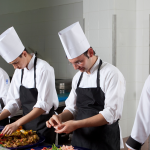When you visit a restaurant or spend time in the kitchen at home, you don’t often think much about safety. A food preparation risk assessment will have been completed.
Want to skip ahead?
Of course, we all know not to let raw meat touch anything we will then use to prepare other foods, and we’re careful with sharp and hot objects, but that’s about the extent of it.
In a professional kitchen, you must take these risks more seriously and consciously. Food safety, and safety in general, must be assessed in depth and employers do this with a risk assessment.
What is a food preparation risk assessment?
A risk assessment is the process of assessing a workplace or process to determine how likely it is that someone may be harmed. This includes:
- How likely someone is to get injured
- How likely it is that someone could get ill
- How serious the risk is
The risk assessment also includes how the hazard can be eliminated, if possible, and managed if not. There are 5 key steps to any risk assessment, which we’ll explain below.
The 5 Steps of a Risk Assessment
Step 1: Identify Hazards
The first step of any risk assessment is to look around the workplace and look for hazards.
Hazards are anything that may cause harm, and so this includes obvious things such as knives and boiling water. As well as hazards we can’t see with the naked eye, such as bacteria.
The food preparation risk assessment should also take into account processes that aren’t daily processes, such as deep cleans of ovens and maintenance of equipment.
Here are a few categories to look out for:
- Risks to physical safety: such as heat, sharp objects, and things falling
- Risks to health: such as chemicals, bacteria, and mould
- Risks to psychological health: occupational stress and aggression from others
- Risks to repetitive strain: where a repetitive task may cause physical pain, or where the work layout causes poor working form
- Electrical risks: any risk of electric shock or fire
- Mechanical risks: any risk of getting a body part trapped in machinery
Step 2: Assess the Hazards
Once you’ve identified all the hazards in your workplace, you need to determine how likely it is that someone could get hurt by the hazard, who could get hurt, and the severity.
Consider who may be affected by the hazards you have identified, and how you can mitigate the risk for each. For example, in a professional kitchen, the chefs will have a lot of risk mitigation in their training and know how to avoid many risks without conscious thought.
Such as not mixing hot oil and cold water. However, a young person working with you on work experience will not have best practices ingrained.
Step 3: Control the Risks
Now you’ve fully identified your hazards and the potential situations where they may cause more or less risk to someone’s safety. It’s time to think about the ways you’re already working to reduce the risk of these hazards, and ways you can do more.
Examples of what you can do include:
- Providing additional safety equipment
- Providing additional safety information
- Replacing outdated equipment
- Relocating materials or equipment
You should put these measures in place at this stage, or make a plan to do so.
Some level of risk is inevitable, but you are required to do all you reasonably can to reduce the risk to your employees, visitors, and customers.
Step 4: Record Your Findings
Any business with less than 5 employees is not required to do this step, but it’s generally good practice to write down your risk assessment findings regardless.
Cover:
- The identified hazard
- Who may be harmed
- What guidelines and practices are already in place to mitigate risk
- What further action can be taken
- Who will carry out that action
- A deadline for the above action
Step 5: Review When Necessary
If there is an accident or near-miss, it’s important to go back to your initial risk assessment of that hazard and consider if there are any further changes you need to make to keep people in the establishment safe.
It’s also important to review your safety practices when:
- There’s an increase in the number of people using a space
- When there’s a change to the tasks being carried out
- When new equipment is introduced
- If anyone starts working who has additional needs (such as a disability)
- When the needs of an employee change (due to pregnancy, an injury sustained outside the workplace, etc)
Example Food Preparation Risk Assessment
So what does a risk assessment look like in practice? Since we’re talking in the context of food preparation here, we’ll cover an example for a restaurant.
Note that traditionally a risk assessment is filled out in a table, as can be seen in the government example here, but we’ll cover an example for one hazard below as questions and answers so you can easily view the example on any device without having to scroll around the screen.
Company Name: Sandy’s Seafood
Date of Risk Assessment: 20/10/22
Hazard: Slipping and tripping
Who may be harmed and how:
Kitchen and service staff in the kitchen, visitors to the kitchen, and customers in the restaurant.
What measures have already been taken:
- Daily cleaning and tidying
- Regular equipment checks and maintenance
- Drainage and drip trays in place where spills are likely
- Spills are cleaned up immediately with effective methods
- Cleaning materials are always readily available
- Lighting is good and maintained in all areas
- No cables are allowed to stretch across walkways without securing appropriately
- Steps and level changes are highlighted
What further action to take:
- Added grip to smooth floor surfaces where spills are likely
- Signs to remind staff to clean up spills immediately
- Suitable footwear encouraged or supplied to staff
Who will take this action:
All will be taken by Ashley (Manager)
Action by: 26/10/22
Action taken: 23/10/22
To fill out a full risk assessment, you simply repeat this simple process for every hazard identified in step 1.
Risk assessments are an important part of any business, but especially for working kitchens where there are risks of injury and illness to employees, customers, and visitors if best practices are neglected.
While risk assessments may not be as exciting as creating delicious meals, they help to keep everyone working or visiting a business safe.



















